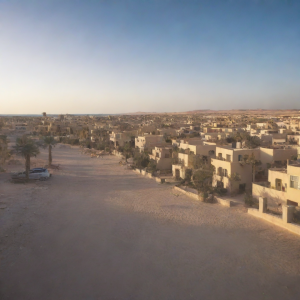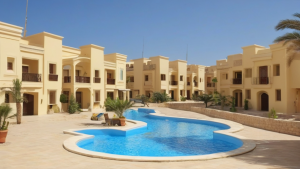Summary about owning and buying property in Hurghada, Egypt.
- Rental yield is a vital metric for anyone interested in property investment.
- It shows the return you can expect on an investment property based on the rental income it generates.
- Simply put, rental yield represents the annual rental income as a percentage of the property’s value.
- While gross rental yield gives a quick snapshot, net rental yield provides a clearer picture of profit potential.
- The definition of a good rental yield varies depending on location, property type, and market conditions.
Understanding what’s a good rental yield and its importance for investors
What rental yield means for property investors
Rental yield is a vital metric for anyone interested in property investment. It shows the return you can expect on an investment property based on the rental income it generates. Simply put, rental yield represents the annual rental income as a percentage of the property’s value. When you understand what’s a good rental yield, you can make smarter investment decisions that meet your financial goals.
Investors use rental yield to compare different properties or markets to decide where to put their money. A higher rental yield often indicates better cash flow, which can help cover expenses like mortgage payments, property maintenance, and taxes. However, a higher yield doesn’t always mean better quality or less risk. Balancing rental yield with other factors like location, property condition, and market trends is crucial.
How to calculate rental yield
Knowing how to calculate rental yield is the foundation for assessing an investment. There are two common ways:
-
Gross Rental Yield: This is the simplest form. You divide the annual rental income by the property’s purchase price and multiply by 100 to get a percentage.
Gross Rental Yield = (Annual Rent / Property Value) × 100
-
Net Rental Yield: This takes expenses like maintenance, insurance, property management fees, and taxes into account. Subtract these costs from the annual rental income before dividing by the property’s value.
Net Rental Yield = ((Annual Rent – Expenses) / Property Value) × 100
While gross rental yield gives a quick snapshot, net rental yield provides a clearer picture of profit potential.
What is a good rental yield?
The definition of a good rental yield varies depending on location, property type, and market conditions. Generally, investors look for a yield that covers their costs and generates positive cash flow.
Typically:
- Below 3%: Considered low yield. May suit long-term capital growth strategies, but less attractive for those seeking immediate income.
- 3% to 6%: Moderate yield. Often found in popular urban areas where property prices are higher but demand is steady.
- Above 6%: High yield. Common in regional or less expensive areas and can offer better cash flow but might carry higher risks like vacancies or less capital appreciation.
Keep in mind, what qualifies as a “good” rental yield depends on your personal investment goals. If you want reliable monthly income, aiming for a higher yield makes sense. But if your focus is on the property’s value rising over time, you might accept a lower yield.
Factors affecting rental yield
Rental yield is influenced by many elements beyond just rent and property price:
- Location: Properties in prime locations tend to have lower yields due to higher prices, but they often provide better capital growth.
- Property Type: Some types, like apartments or single-family homes, may attract different rental demand and behave differently in markets.
- Market Conditions: Economic cycles, rental demand, and interest rates can impact yields.
- Vacancy Rates: Higher vacancy means less rent income and reduces net yield.
- Maintenance Costs: Older properties may have higher expenses, cutting into profit.
Evaluating these factors helps you get a realistic idea of rental yield and overall investment viability.
How to find good rental yield opportunities
Finding a good rental yield involves research and analysis. Here are some strategies:
- Study Local Markets: Look at different neighborhoods and compare rental prices with property costs. Online property portals and market reports provide useful data.
- Calculate Thoroughly: Don’t just rely on advertised rent or purchase price. Account for all expenses like repairs, agent fees, and taxes to determine net rental yield.
- Consult with Experts: Real estate agents, property managers, and financial advisors can offer insights about promising rental markets.
- Consider Emerging Areas: Newly developing suburbs might offer higher yields as property prices are still affordable but rental demand is growing.
- Analyze Vacancy Rates: Ensure the area has strong rental demand to minimize the risk of empty periods without rent income.
Balancing rental yield and capital growth
While a high rental yield sounds appealing, it’s essential to balance it with potential capital growth. Some properties offer excellent yields but limited appreciation, while others gain value over time but yield less income. A balanced investment considers both income and asset growth to build wealth.
For example, city center apartments might have low yields but benefit from rising prices, while regional properties may yield more immediately but appreciate slower.
Final thoughts on rental yields
Understanding what’s a good rental yield is key to evaluating property investments effectively. Focus on getting accurate calculations, researching local markets, and aligning yields with your investment goals. Remember that a good rental yield varies based on your priorities,whether that’s steady income or long-term growth. Make decisions based on facts and thorough analysis instead of just chasing high percentages.
Practical strategies to calculate and find optimal rental yields in your area
Understanding rental yield: what you need to know
Rental yield is a key metric that property investors use to measure the potential return on investment from rental income. Simply put, it represents the annual rental income expressed as a percentage of the property’s value. Knowing what’s a good rental yield and how to find it can make a significant difference in maximizing your investment’s profitability.
Rental yield is generally classified into two types:
- Gross Rental Yield: This is calculated by dividing the annual rent by the property’s purchase price, then multiplying by 100 to get a percentage.
- Net Rental Yield: This takes into account all expenses related to the property, including maintenance, taxes, property management fees, insurance, and vacancies. It provides a more realistic view of the actual return you’re earning.
For example, if your property is worth $300,000 and you receive $18,000 annually in rent, your gross rental yield is (18,000 ÷ 300,000) × 100 = 6%. If your yearly expenses total $5,000, your net rental yield drops to ((18,000 – 5,000) ÷ 300,000) × 100 = 4.33%.
Factors influencing a good rental yield
Determining a “good” rental yield depends heavily on local market conditions, property type, and your investment goals. Generally, a rental yield between 5% and 8% is considered reasonable in many markets, but this varies:
- Location: Urban areas with high demand might offer lower yields because property prices are higher, while regional or suburban areas might show higher yields but come with more risk or lower growth potential.
- Property Type: Apartments often yield less than single-family homes or multi-family units due to management costs and tenant turnover rates.
- Market Trends: Economic factors such as employment rates, population growth, and interest rates impact rental demand and property values, influencing yields.
While chasing high yields can be tempting, properties with exceptionally high rental yields might have hidden risks, like poorly maintained buildings or less desirable neighborhoods. Balancing yield with growth potential and property quality is crucial.
Step-by-step: how to calculate rental yield for your investment
Knowing how to calculate rental yield accurately helps you compare properties fairly. Follow this simple method:
- Find the Annual Rental Income: If rent is monthly, multiply that amount by 12.
- Determine the Property Value: Use the purchase price or current market value.
- Calculate Gross Yield: Divide the annual rent by the property value, then multiply by 100.
- Estimate Annual Expenses: Include taxes, insurance, maintenance, property management fees, and allowances for vacancy periods.
- Calculate Net Yield: Subtract expenses from rental income, divide by property value, then multiply by 100.
Using this process gives you a clearer picture of how much return you can expect and helps you identify the best deals.
Finding optimal rental yields in your area
To track down properties with good rental yields, start with thorough market research. Here are practical strategies:
- Analyze Local Market Data: Access property websites, rental listings, and government or real estate reports to understand average rental prices and property values.
- Consult Real Estate Agents and Property Managers: Professionals with local experience can give insights into neighborhoods with strong rental demand and balanced yields.
- Use Online Calculators and Tools: Platforms offering rental yield calculators can help you quickly estimate yields for properties you’re interested in.
- Focus on Emerging Areas: Neighborhoods with new infrastructure, schools, or businesses often offer opportunities for higher yields as demand grows.
- Compare Similar Properties: Look at how similar properties perform across price points, types, and locations to spot trends and outliers.
Balancing rental yield with other investment goals
High rental yields should not be the sole factor edging your decision. Consider how rental yield fits with your overall strategy:
- Capital Growth Potential: Properties in up-and-coming areas may offer lower yields now but can appreciate substantially over time.
- Risk Management: Lower-yield properties in stable areas might provide more consistent returns with fewer vacancies.
- Cash Flow Needs: If you rely on rental income for ongoing expenses, focus on properties delivering positive monthly cash flow.
Therefore, look at rental yield as part of a bigger picture involving market trends, your financial goals, and risk tolerance.
Key tips to maximize rental yield
Once you identify a property with good rental yield potential, certain strategies can help improve it further:
- Upgrade the Property: Renovations or adding amenities often allow charging higher rent.
- Reduce Expenses: Shop for better insurance rates, choose cost-effective property managers, and maintain the property regularly to avoid costly repairs.
- Focus on Tenant Retention: Keeping good tenants reduces vacancy costs, boosting net rental yield.
- Market Effectively: Use strong advertising to minimize vacant periods between tenants.
These practical steps ensure you get the most out of your investment beyond the initial yield calculation.
Understanding what’s a good rental yield and mastering how to calculate and find it in your area empowers you to make informed property investment decisions. With careful analysis and strategic action, you can optimize returns and build a rental portfolio that meets your financial goals.
Knowing what defines a good rental yield is key for every property investor aiming to maximize returns. A solid rental yield not only reflects the income potential of your investment but also helps you compare different properties and markets effectively. Understanding this metric gives you a clear picture of how your investment will perform in the long run.
By using practical strategies to calculate rental yield, you can confidently assess whether a property offers good value. Simple calculations, combined with researching local market trends, allow you to pinpoint optimal rental yields in your area. This approach ensures you make informed decisions instead of relying on guesswork or assumptions.
Ultimately, finding the right rental yield is about balancing income with property costs, risk, and market conditions. Focusing on this metric empowers you to identify opportunities that deliver steady cash flow and build long-term wealth. With a firm grasp on what makes a good rental yield and how to find it, you are better prepared to navigate the property market and select investments that truly pay off.










